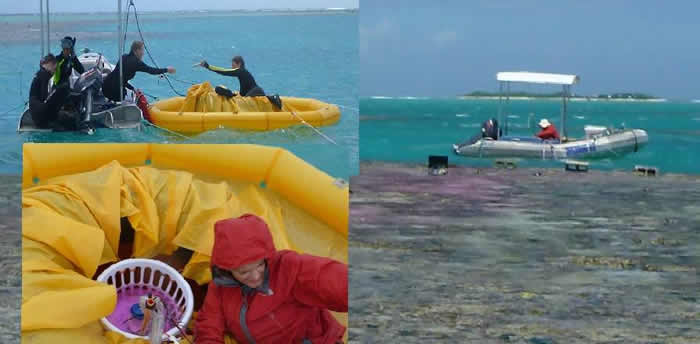 |
|
|
Environmental Products
Read More about this coral reef study shown here in our blog.
A Simple looking bag does an important job for Clmate change
These bags look deceptively simple, but they are just the right size and shape to protect
sensitive electronic equipment that is used to measure climate at the tops of old-growth trees.
This equipment is required so that sensitive measurements of tree growth can be compared
with local climate to determine which climate conditions are important and at which times
of the year. Understanding this is critical to determine how climate change will affect
Northwest conifer growth. I would hope to have more information for you, but the science
involved here is over my head. I am a humble bag maker.
Manatee Rescue Platform made with inflatable tubes and Drop stitch.
We hope to have videos of an actual rescue soon.
Inflatable cataraft for scientific river study After using my Stretch Flyer Cat for channel mapping on the Snake in 2010, I was asked by Carl Legleiter, a University of Wyoming geomorphologist, to build a research boat for the 2011 field season. Having built several modular whitewater frames with SpeedRail fittings, I designed a new one to mount the equipment we planned to use for measuring the depth, current speed, current direction, reflectance, turbidity, and other characteristics. See the whole story with multiple pictures and explainations at this web site. Universtiy of Wyoming river research
Inflatable floating weir fence helps control salmon As of July 21, 2011 we are under contract to build this unique inflatable device to help control salmon runs near the City of Seattle. The part you see in the picture above is the weir fence, and it is supported by an inflatable in 3 separate sections, that are tied to the fence to keep it afloat. Twice a day the tubes are deflated and debris washes off of the fence. For this reason the hoses must run inside of a skin that is attached to the fence. The inflation tubes are 1.5 inches in diameter. For more detail, have a look at the single tube and skin. Cory Cuthburtson Is the fellow who I worked with on the design of this thing, and he is the operator of the facility. I appreciated his patience with me since I did not really know what we were doing for quite some time. He helped me get it. Here is what he had to say about this design and the product. So a lot of the credit goes to having good customers who are willing to work with us to get us to understand the issues involved. THE PONTOONS ARE AWESOME!!!
They worked perfectly as soon as we hooked them up, exactly as we hoped.
You guys do really good work and we are totally happy with the product
that we got. We're already seeing operational advantages over our old
equipment and as the river flows pick up this fall we'll be appreciating
those pontoons even more.
.I'll definitely be recommending you guys if anyone is
looking for a similar product in the future. I'm totally confident that
you would be able to provide a top quality product.
Industrial Composting Tubes CompDogs™ are Trademarked and patented by Engineered Compost Systems. USGS Clear Plastic Chamber for Ocean Water Chemistry Studies http://sofia.usgs.gov/publications/ofr/00-361/sharq.html Oil and Gas Spill Containment - Inflatable and Self Inflating It has a Schrader valve for emergency inflation and only 2 handles. Both designs have 180 gallon capacity. With a higher skirt the capacity could be much more. Please have a look at the press release we are sending out on this product. Oil and Gas Spill Containment - Foam Filled Inflatable containment system 18 ft by 24 ft 9.5 inches high This containment was purchased by a nuclear power plant in South Carolina. It has the 42 oz material bottom, and is super stout. It is built around the inflatable tray system. In other words, the tray is built and attached to the inflatable. In this same way we can make the tray and put individual tubes on the outside so that a truck could drive in and out. This gives the capability to decontaminate a vehicle and keep the water from draining off. See the corner detail concept, the tray detail concept, and the big picture. This next link is a 10 x 10 ft inflatable containment with a lighter duty truck tarp bottom material. This containment floated on the water under a bridge to keep lead paint chips out of the water when the bridge was being repainted. We are happy to work with our customers on all variations. Floating Fish Finder Here are Mark’s Comments: "I just wanted to send you a couple of pictures on our floating PIT tag antenna that you built for us. It actually worked pretty well and we are thinking about building some more. We were able to detect about the same number of fish as an electrofisher that was going down the river at the same time. We may also try to build some that are 20 feet long and rig them in series so they can span the entire river." Contact Mark or Peter at these email addresses for more information. Mark’ specialty is Fish Biology, and Peter’s specialty is the antenna and electrical hardware that was built into the large rectangular floats. Industrial Sled Tubes For Greenland Traverse More on the GRIT project, and more about the Arctic.
|
Order inquiries: shop.jpwinc@gmail.com © 2011 Jack's Plastic Welding, Inc
|
|


